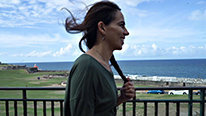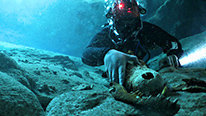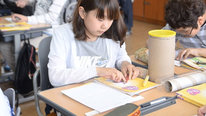NSF Awards: 1515507
With more than 54 million individuals, the Hispanic population is now the United States’ largest ethnic minority group. Latinas are the largest group of minority females, constituting 8% of the population. However, only 2 percent of Latinas held science and engineering positions in 2015, as reported by the NSF and in 2017 NCWIT reported that Latinas made up only 1 percent of the computing workforce. SciGirls is rooted in research-based strategies proven to engage girls in STEM and in the need to address specific barriers that prevent many girls from engaging in STEM, including limited exposure to role models. Research shows that young Latinas have high interest in STEM but have less support and exposure to STEM professionals than their non-Latinx peers. Role models are critical for minority students, for even those who do well in STEM often struggle to identify with STEM fields because they cannot find connections to their lives.
To address this challenge, SciGirls created a series of twelve short-form role model profiles of diverse Latina STEM professionals for use in educational settings. These Latinas are innovators, problem-solvers and science superstars who celebrate their heritage and culture. They’re passionate about their work, hobbies, families and helping to make the world a better place. They share their strategies and pathways in jobs where Latinas are under-represented, and motivate girls to pursue all kinds of interests and career paths. The series feature Latinas in a variety of professions including technology, engineering, biology, ecology, medicine and geoarcheology.









Alicia Santiago
Science Advisor & Latino Engagement Specialist
¡Hola!
This is Alicia, a Co-PI on the Latina SciGirls project! Latinas at Work are a series of twelve short role model profiles of diverse Latina STEM professionals that are designed to inspire girls in STEM.
Do you work with middle school girls? If so, please let us know if you think producing profiles of younger women (e.g. high-school and college-age students) would be more effective to encourage more girls to pursue STEM. We would love any feedback and would be happy to answer any questions you might have.
Gracias, and enjoy the showcase!
Roxanne Hughes
Hi Alicia and Brenda!! This is such a great project. Have you had a chance to assess the impact of the project on youth - particularly the role models piece?
Brenda Britsch
Sr. Research Scientist
Thank you Roxanne! The project has comprehensive evaluation and research components. The evaluation is focused more on the delivery of the program and the educators (and has shown very positive results), but does include some findings related to the youth participants and the female STEM role models who were involved in the project.
The girls involved in the project (and their parents) strongly agreed that they 'learned a lot from the STEM professionals and that they were good role models'. They also reported that they enjoyed hearing the role models talk about their work, personal life and background, felt they could relate to the role models and that they discussed topics that were relevant to their lives.
In addition, the majority of youth participants reported increased awareness of and interest in STEM professions; a heightened understanding of the preparation/education necessary to achieving these careers; and more interest in taking related STEM courses in high school.
The research component was more focused on the impact of the youth participants and we will have final results from the research study soon. Preliminary data show a positive impact on the youth, however, including increased emotional connection and personal relevance to STEM. We would be happy to share more of the research findings with you when they are ready.
Brenda
Abigail Zoger
I would be interested in learning more about the different pieces of the project. Are there resources that have been developed that could be used in other settings? We are a Hispanic Serving Institution and have and SSTEM program at our school that is focused on mentorship of high achieving, low income students.
Brenda Britsch
Sr. Research Scientist
Hi Abigail,
Thank you for your interest! Yes, there are additional resources that have been developed as part of the larger Latina SciGirls project.
Our main website for educator resources (all thing SciGirls, not just Latina SciGirls) is www.scigirlsconnect.org
You will find links to the episodes in Spanish (Season 4) as well as activities developed for the LSG project.
Also, here are other helpful links:
Latinas at Work half hour special: https://www.tpt.org/scigirls/video/scigirls-stories-latinas-at-work-hypgil/
Our full collection of role model profiles, including Latinas in STEM: http://www.scigirlsconnect.org/resource_topic/role-model-profiles/
More video and activity resources in Spanish: http://www.scigirlsconnect.org/home-espanol/
Brenda Britsch
Sr. Research Scientist
Also, here is the trailer for Season 4 that was filmed primarily in Spanish:
https://www.youtube.com/watch?v=odsJIdNS11w&...
Rabiah Mayas
Associate Director
Thank you, Alicia, Brenda and Angie, for sharing your project and for highlighting the whole-life experience of Latina STEM professionals. On a technical note, I appreciated in particular the bilingual captioning throughout as a model for other programs engaging multilingual audiences. I also have a question about evaluation, related to the findings you mentioned above with the role models.
Have you found any impact of participating in SciGirls on the professionals' ongoing interest in role modeling and public communication? I'm curious if - for role models who may not already be deeply engaged in this area - your program might serve as a gateway to long-term pursuit of public engagement?
Alicia Santiago
Science Advisor & Latino Engagement Specialist
Thanks Rabiah!
Your question is very interesting, and we are excited to share that the role model STEM professionals that participated in the project showed great interest in visiting other programs as role models. They also indicated that they had a greater appreciation of the value of communicating to youth about their jobs and careers. And also mentioned that they felt more confident in their ability to communicate with youth about their work. We were very excited to see that the program also had a positive impact on the role models and as you mentioned, we believe that it might encourage them to continue engaging youth and their families in STEM! :)
Noah Feinstein
Associate Professor
SciGirls has such a great track record. I love to see that your work is going in this direction. When I watched this video, I was struck by the different reasons the STEM professionals gave for being excited about their work - and for getting young Latinas excited about STEM. Some emphasized the value they could add to STEM fields - others the importance of opening doors - or the intrinsic rewards of the work. Did you seek out these different perspectives deliberately, or did it just emerge from your interviews? Do you know anything about which stories the viewers found most compelling?
I'm also impressed by the diversity of Latinas in this video - that seems like a deliberate (and important) attempt to push back against a monolithic stereotype. Is there any material in the videos that touches on cultural identity within that overall category? (i.e., "As a Chicana, it is really important to me that...")
Brenda Britsch
Sr. Research Scientist
Noah,
Thank you so much for watching our video! We appreciate your interest.
Great questions. I agree that it's nice to see the different reasons for the role models being excited about their work. I will let my colleague Angie elaborate on how that came out in the interviews.
To your 2nd question... Yes! We did deliberately seek out Latina role models who were diverse in terms of cultural background and identity. We wanted to acknowledge and represent the diversity of Latinas living in the U.S. and help young first generation Latinas be able to connect with the role models, regardless of where they are from and what their cultural background is. Some of the role models do discuss this a bit in their interviews. Also, we tried to do the same in our episodes, so we filmed the Latina SciGirls episodes in different regions of the U.S. with girls who also come from a variety of backgrounds.
Brenda
Noah Feinstein
Angie Prindle
Series Producer, SciGirls
Thanks, Noah!
Thanks so much for your interest and wonderful questions. I appreciate that you mentioned the diversity of Latinas in the video. We selected our role models with a focus on diversity at all levels: STEM field, personal and family backstory, cultural background, geographic location, formative experiences and influences, even hobbies and interests outside of work! One of the goals of selecting a diverse cohort of role models was to provide a wide range of prospective affinity points to engage and inspire girls viewing these videos. A diversity of perspectives naturally emerged in the storytelling process based on the many unique personal and professional experiences of the women featured in the video. In the editing and post production phase we were intentional about highlighting- and celebrating- these important perspectives for overall narrative variety across the collection of profiles.
While we don't have any formal data on which of the individual stories viewers found most compelling, initial results of our external media evaluation show that Latina girls and their families responded positively and found the role models relatable.
Noah Feinstein
Karin Lohwasser
Thank you, I think the videos you are mentioning in your overview here are really useful, and I will incorporate them in my work with teacher candidates. Would it be an idea to include in your thread here the direct link to these videos for easier access?
Angie Prindle
Series Producer, SciGirls
Thanks for your interest, Karin! Here are links to our downloadable videos and activities:
Latinas at Work half hour special: https://www.tpt.org/scigirls/video/scigirls-stories-latinas-at-work-hypgil/
Our full collection of role model profiles, including Latinas in STEM: http://www.scigirlsconnect.org/resource_topic/role-model-profiles/
More video and activity resources in Spanish: http://www.scigirlsconnect.org/home-espanol/
Jason Aloisio
This is wonderful!
Is the content produced for a target age-group?
Brenda Britsch
Sr. Research Scientist
Thank you Jason. Yes, the project is aimed at 8-13 year olds, but I feel the role model vidoes are relevant to girls/young women who are older as well, especially making connections to possible careers.
Brenda
Perla Myers
I love the videos and activities! Thank you so much for this great work! We have used some of your videos for our project boosters, and they are wonderful! We work with students in a primarily Hispanic community, so they are perfect.
Brenda Britsch
Sr. Research Scientist
Thank you Perla! We are so glad to hear it. We hope they are helpful to you and look forward to any other feedback you might have.
Brenda
Anne Kern
Associate Professor
Promotion of females in STEM is so important in serving a balanced and represented society!
So, here is my nagging question: it seems that we have been at this for at least the last 20-years, specific and focused programs-workshops, mentors, courses, etc we still have issues. Sure, I am impatience but besides attending to the gender and patriarchal inequities, what more can be done to make really sustained societal and systematic changes?
Thoughts?
Brenda Britsch
Sr. Research Scientist
Anne,
I totally understand your question/point. Yes, we are still working to broaden participation and increase equity in STEM and we still have challenges. However, there is so much more being done today than even 10 years ago and I do think we're making progress. Everything you mentioned, if done well, helps! And we believe the new wave of role models that our young women are being exposed to is definitely a part of the solution.
Thank you for viewing our video and for your thoughts!
Brenda
Alicia Santiago
Science Advisor & Latino Engagement Specialist
Hi Anne!
I agree with Brenda that we are definitely making progress towards broadening participation and increasing equity in STEM. Things are definitively improving for women in STEM, but I also think we can do more. Interestingly, most efforts to increase participation of women in STEM focus exclusively on the women/girls themselves. It occurs to me that an interesting approach that would help to start making sustained societal and systematic changes, could involve focusing on working with boys to begin to instill the value of female STEM perspectives in them. It would be interesting to design STEM programs aimed at forming young men/boys perceptions about females in STEM. For example having a program where we have female role models and mentors for boys. At the same time that we are empowering girls and women in STEM, I think we could also be working with boys/young males to decrease their gender stereotypical views about STEM ability.
Anne Kern
Associate Professor
Hi Alicia,
I love your thinking because I think there is a need to shift the thinking of the other 50%! I recently gave a panel presentation with a group of female colleagues, most of us were of color. We were talking about mentoring other women of color, in STEM fields as well as others. Anyhow, we were asked by a male colleague in the audience about how "they" as in males could help... One of my female colleagues mentioned starting to cite more females in papers! I thought that was a great and interesting response! What do you think?
Alicia Santiago
Science Advisor & Latino Engagement Specialist
Hi again Anne!
Yesss! We definitely need to shift the thinking of the other 50%! That is something that I think we need to emphasize with our colleagues (men and women), students, AND parents. Research shows that STEM stereotypes about ability and about "brilliance = males", appear in children at a very young age (6 years of age). Part of the reason is that that young kids acquire stereotypes by listening and watching adults; many parents believe STEM stereotypes! Thus, it is important that teachers/educators and parents become aware of this and help encourage a growth mindset in girls.
I think educators are doing a great job in helping girls develop a growth mindset and become more resilient. But that is only one part of the problem. We also need to work with young males and adults (parents) to be able to reach equity in STEM education.
Further posting is closed as the showcase has ended.